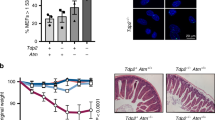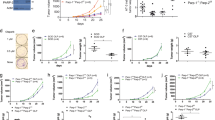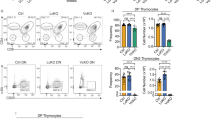Abstract
Poly(ADP-ribose) polymerase-2 (Parp-2) belongs to a family of enzymes that catalyse poly(ADP-ribosyl)ation of proteins. Parp-2 deficiency in mice (Parp-2−/−) results in reduced thymic cellularity associated with increased apoptosis in thymocytes, defining Parp-2 as an important mediator of T-cell survival during thymopoiesis. To determine whether there is a link between Parp-2 and the p53 DNA-damage-dependent apoptotic response, we have generated Parp-2/p53-double-null mutant mice. We found that p53−/− backgrounds completely restored the survival and development of Parp-2−/− thymocytes. However, Parp-2-deficient thymocytes accumulated high levels of DNA double-strand breaks (DSB), independently of the p53 status, in line with a function of Parp-2 as a caretaker promoting genomic stability during thymocytes development. Although Parp-2−/− mice do not have spontaneous tumours, Parp-2 deficiency accelerated spontaneous tumour development in p53-null mice, mainly T-cell lymphomas. These data suggest a synergistic interaction between Parp-2 and p53 in tumour suppression through the role of Parp-2 in DNA-damage response and genome integrity surveillance, and point to the potential importance of examining human tumours for the status of both genes.
This is a preview of subscription content, access via your institution
Access options
Subscribe to this journal
Receive 50 print issues and online access
$259.00 per year
only $5.18 per issue
Buy this article
- Purchase on Springer Link
- Instant access to full article PDF
Prices may be subject to local taxes which are calculated during checkout



Similar content being viewed by others
References
Bai P, Houten SM, Huber A, Schreiber V, Watanabe M, Kiss B et al. (2007). Poly(ADP-ribose) polymerase-2 controls adipocyte differentiation and adipose tissue function through the regulation of the activity of the retinoid X receptor/peroxisome proliferator-activated receptor-gamma heterodimer. J Biol Chem 282: 37738–37746.
Bassing CH, Ranganath S, Murphy M, Savic V, Gleason M, Alt FW . (2008). Aberrant V(D)J recombination is not required for rapid development of H2ax/p53-deficient thymic lymphomas with clonal translocations. Blood 111: 2163–2169.
Beneke R, Möröy T . (2001). Inhibition of poly(ADP-ribose) polymerase activity accelerates T-cell lymphomagenesis in p53 deficient mice. Oncogene 20: 8136–8141.
Bryant HE, Schultz N, Thomas HD, Parker KM, Flower D, Lopez E et al. (2005). Specific killing of BRCA2-deficient tumours with inhibitors of poly(ADP-ribose) polymerase. Nature 434: 913–917.
Chen HT, Bhandoola A, Difilippantonio MJ, Zhu J, Brown MJ, Tai X et al. (2000). Response to RAG-mediated VDJ cleavage by NBS1 and gamma-H2AX. Science 290: 1962–1965.
Conde C, Mark M, Oliver FJ, Huber A, de Murcia G, Menissier-de Murcia J . (2001). Loss of poly(ADP-ribose) polymerase-1 causes increased tumour latency in p53-deficient mice. EMBO J 20: 3535–3543.
Dantzer F, Mark M, Quenet D, Scherthan H, Huber A, Liebe B et al. (2006). Poly(ADP-ribose) polymerase-2 contributes to the fidelity of male meiosis I and spermiogenesis. Proc Natl Acad Sci USA 103: 14854–14859.
Difilippantonio MJ, Zhu J, Chen HT, Meffre E, Nussenzweig MC, Max EE et al. (2000). DNA repair protein Ku80 suppresses chromosomal aberrations and malignant transformation. Nature 404: 510–514.
Farmer H, McCabe N, Lord CJ, Tutt AN, Johnson DA, Richardson TB et al. (2005). Targeting the DNA repair defect in BRCA mutant cells as a therapeutic strategy. Nature 434: 917–921.
Fong PC, Boss DS, Yap TA, Tutt A, Wu P, Mergui-Roelvink M et al. (2009). Inhibition of poly(ADP-ribose) polymerase in tumors from BRCA mutation carriers. N Engl J Med 361: 123–134.
Frank KM, Sharpless NE, Gao Y, Sekiguchi JM, Ferguson DO, Zhu C et al. (2000). DNA ligase IV deficiency in mice leads to defective neurogenesis and embryonic lethality via the p53 pathway. Mol Cell 5: 993–1002.
Gao Y, Ferguson DO, Xie W, Manis JP, Sekiguchi J, Frank KM et al. (2000). Interplay of p53 and DNA-repair protein XRCC4 in tumorigenesis, genomic stability and development. Nature 404: 897–900.
Hakem R . (2008). DNA-damage repair; the good, the bad, and the ugly. EMBO J 27: 589–605.
Hawwari A, Bock C, Krangel MS . (2005). Regulation of T cell receptor alpha gene assembly by a complex hierarchy of germline Jalpha promoters. Nat Immunol 6: 481–489.
Huber A, Bai P, de Murcia JM, de Murcia G . (2004). PARP-1, PARP-2 and ATM in the DNA damage response: functional synergy in mouse development. DNA Repair (Amst) 3: 1103–1108.
Lee GS, Neiditch MB, Salus SS, Roth DB . (2004). RAG proteins shepherd double-strand breaks to a specific pathway, suppressing error-prone repair, but RAG nicking initiates homologous recombination. Cell 117: 171–184.
Mak TW, Hakem A, McPherson JP, Shehabeldin A, Zablocki E, Migon E et al. (2000). Brcal required for T cell lineage development but not TCR loci rearrangement. Nat Immunol 1: 77–82.
Menissier dM, Ricoul M, Tartier L, Niedergang C, Huber A, Dantzer F et al. (2003). Functional interaction between PARP-1 and PARP-2 in chromosome stability and embryonic development in mouse. EMBO J 22: 2255–2263.
Paques F, Haber JE . (1999). Multiple pathways of recombination induced by double-strand breaks in Saccharomyces cerevisiae. Microbiol Mol Biol Rev 63: 349–404.
Petrie HT, Livak F, Schatz DG, Strasser A, Crispe IN, Shortman K . (1993). Multiple rearrangements in T cell receptor alpha chain genes maximize the production of useful thymocytes. J Exp Med 178: 615–622.
Riley T, Sontag E, Chen P, Levine A . (2008). Transcriptional control of human p53-regulated genes. Nat Rev Mol Cell Biol 9: 402–412.
Robert I, Dantzer F, Reina-San-Martin B . (2009). Parp1 facilitates alternative NHEJ, whereas Parp2 suppresses IgH/c-myc translocations during immunoglobulin class switch recombination. J Exp Med 206: 1047–1056.
Rogakou EP, Pilch DR, Orr AH, Ivanova VS, Bonner WM . (1998). DNA double-stranded breaks induce histone H2AX phosphorylation on serine 139. J Biol Chem 273: 5858–5868.
Rooney S, Sekiguchi J, Whitlow S, Eckersdorff M, Manis JP, Lee C et al. (2004). Artemis and p53 cooperate to suppress oncogenic N-myc amplification in progenitor B cells. Proc Natl Acad Sci USA 101: 2410–2415.
Schreiber V, Dantzer F, Ame JC, de Murcia G . (2006). Poly(ADP-ribose): novel functions for an old molecule. Nat Rev Mol Cell Biol 7: 517–528.
Shiloh Y . (2003). ATM and related protein kinases: safeguarding genome integrity. Nat Rev Cancer 3: 155–168.
Sonoda E, Sasaki MS, Buerstedde JM, Bezzubova O, Shinohara A, Ogawa H et al. (1998). Rad51-deficient vertebrate cells accumulate chromosomal breaks prior to cell death. EMBO J 17: 598–608.
Tentori L, Muzi A, Dorio AS, Bultrini S, Mazzon E, Lacal PM et al. (2008). Stable depletion of poly (ADP-ribose) polymerase-1 reduces in vivo melanoma growth and increases chemosensitivity. Eur J Cancer 44: 1302–1314.
Tong WM, Cortes U, Hande MP, Ohgaki H, Cavalli LR, Lansdorp PM et al. (2002). Synergistic role of Ku80 and poly(ADP-ribose) polymerase in suppressing chromosomal aberrations and liver cancer formation. Cancer Res 62: 6990–6996.
Tong WM, Hande MP, Lansdorp PM, Wang ZQ . (2001). DNA strand break-sensing molecule poly(ADP-ribose) polymerase cooperates with p53 in telomere function, chromosome stability, and tumor suppression. Mol Cell Biol 21: 4046–4054.
Tong WM, Ohgaki H, Huang H, Granier C, Kleihues P, Wang ZQ . (2003). Null mutation of DNA strand break-binding molecule poly(ADP-ribose) polymerase causes medulloblastomas in p53(−/−) mice. Am J Pathol 162: 343–352.
Tong WM, Yang YG, Cao WH, Galendo D, Frappart L, Shen Y et al. (2007). Poly(ADP-ribose) polymerase-1 plays a role in suppressing mammary tumorigenesis in mice. Oncogene 26: 3857–3867.
von Boehmer H, Aifantis I, Feinberg J, Lechner O, Saint-Ruf C, Walter U et al. (1999). Pleiotropic changes controlled by the pre-T-cell receptor. Curr Opin Immunol 11: 135–142.
von Boehmer H, Fehling HJ . (1997). Structure and function of the pre-T cell receptor. Annu Rev Immunol 15: 433–452.
Werlen G, Hausmann B, Naeher D, Palmer E . (2003). Signaling life and death in the thymus: timing is everything. Science 299: 1859–1863.
Wang Z, Stingl L, Morrison C, Jantsch M, Los M, Schulze-Osthoff K et al. (1997). PARP is important for genomic stability bus dispensable in apoptosis. Genes Dev 11: 2347–2358.
Xu M, Yu Q, Subrahmanyam R, Difilippantonio MJ, Ried T, Sen JM . (2008). Beta-catenin expression results in p53-independent DNA damage and oncogene-induced senescence in prelymphomagenic thymocytes in vivo. Mol Cell Biol 28: 1713–1723.
Yelamos J, Monreal Y, Saenz L, Aguado E, Schreiber V, Mota R et al. (2006). PARP-2 deficiency affects the survival of CD4+CD8+ double-positive thymocytes. EMBO J 25: 4350–4360.
Yelamos J, Schreiber V, Dantzer F . (2008). Toward specific functions of poly(ADP-ribose) polymerase-2. Trends Mol Med 14: 169–178.
Acknowledgements
We thank Katherine Papageorgiou for assistance with handling the mice and Sergi Mojal for statistical analysis support. This work was supported by Spanish Ministerio de Ciencia e Innovación (Grant SAF2008-01572 to JY); Generalitat de Catalunya (Grant 2009/SGR/524 to JY); Instituto de Salud Carlos III (Grant PI081150 to PA); Fundación Séneca (Grant 08643/PI/08 to PA); and funds from Centre National de la Recherche Scientifique, Association pour la Recherche contre le Cancer, Electricité de France, Comité du Haut-Rhin de la Ligue Nationale Contre le Cancer and Commissariat à l’Energie Atomique (VS, FD). LN is supported by the Spanish Ministerio de Ciencia e Innovación and AB-M is supported by Instituto de Salud Carlos III (Madrid, Spain) and the FFIS (Murcia, Spain).
Author information
Authors and Affiliations
Corresponding author
Ethics declarations
Competing interests
The authors declare no conflict of interest.
Additional information
Supplementary Information accompanies the paper on the Oncogene website
Rights and permissions
About this article
Cite this article
Nicolás, L., Martínez, C., Baró, C. et al. Loss of poly(ADP-ribose) polymerase-2 leads to rapid development of spontaneous T-cell lymphomas in p53-deficient mice. Oncogene 29, 2877–2883 (2010). https://doi.org/10.1038/onc.2010.11
Received:
Revised:
Accepted:
Published:
Issue Date:
DOI: https://doi.org/10.1038/onc.2010.11
Keywords
This article is cited by
-
Coordinated signals from PARP-1 and PARP-2 are required to establish a proper T cell immune response to breast tumors in mice
Oncogene (2020)
-
Coordinated signals from the DNA repair enzymes PARP-1 and PARP-2 promotes B-cell development and function
Cell Death & Differentiation (2019)
-
PARP-1/PARP-2 double deficiency in mouse T cells results in faulty immune responses and T lymphomas
Scientific Reports (2017)
-
PARP-2 sustains erythropoiesis in mice by limiting replicative stress in erythroid progenitors
Cell Death & Differentiation (2015)
-
Poly(ADP-ribosyl)ation in regulation of chromatin structure and the DNA damage response
Chromosoma (2014)



